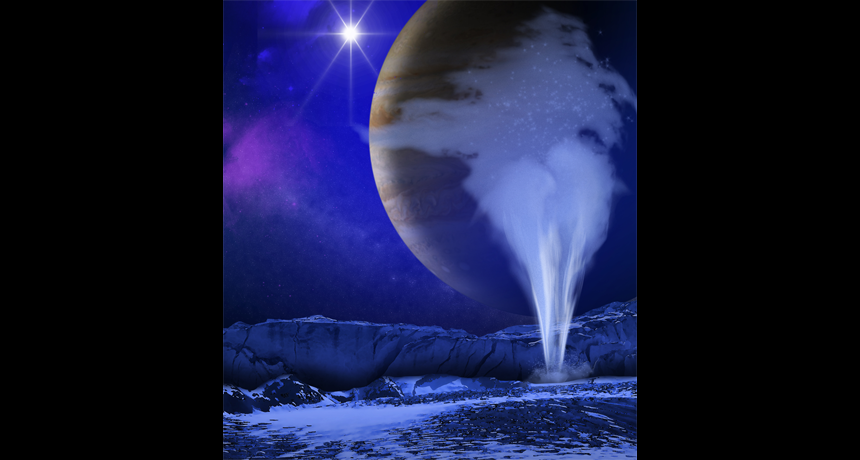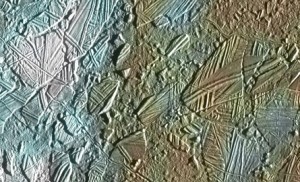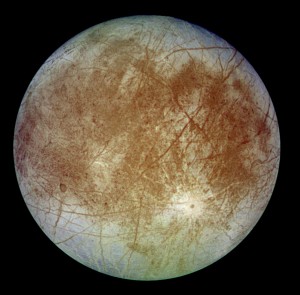Europa’s watery underworld
Jupiter’s smooth, icy moon may hide giant lakes beneath the surface

Artist's vision of a plume of water vapor spewing from Europa's surface.
NASA/ESA/K. Retherford/SWRI
Europa, one of Jupiter’s 63 known moons, looks bright and icy on the surface. But appearances can be deceiving: Miles within its cracked, frigid shell, Europa probably hides giant pools of liquid water. Where scientists find liquid water, they hope to find life as well.
Since we can’t go diving into Europa’s depths just yet, scientists instead have to investigate the moon’s surface for clues to what lies beneath. In a new study, scientists investigated one group of strange ice patterns on Europa and concluded that the formations mark the top of an underground pool that holds as much water as the U.S. Great Lakes.

Pictures of Europa, which is slightly smaller than Earth’s moon, clearly show a tangled, icy mishmash of lines and cracks known as “chaos terrains.” These chaotic places cover more than half of Europa. For more than 10 years, scientists have wondered what causes the formations. The new study suggests that they arise from the mixing of vast underground stores of liquid water with icy material near the surface.
For scientists who suspect that Europa also may be hiding life beneath its icy surface, the news about the new lake is exciting.
“It would be great if these lakes harbored life,” Britney Schmidt, a planetary scientist who worked on the study, told Science News. “But even if they didn’t, they say that Europa is doing something interesting and active right now.”

Schmidt, a scientist at the University of Texas at Austin, and her colleagues wanted to know how chaos terrains form. Since they couldn’t rocket to Europa to see for themselves, they searched for similar formations here on Earth. They studied collapsed ice shelves in Antarctica and icy caps on volcanoes in Iceland. Those features on Earth formed when liquid water mixed with ice. The scientists now suspect something similar might be happening on Europa: that as water and ice of different temperatures mingle and shift, the surface fractures. This would explain the jumbled ice sculptures.
“Fracturing catastrophically disrupts the ice in the same way that it causes ice shelves to collapse on Earth,” Schmidt told Science News. She and her team found that the process could be causing chaos terrains to form quickly on Europa.
The new study suggests that on this moon, elements such as oxygen from the surface blend with the deep bodies of water. That mixture may create an environment that supports life.
Don Blankenship, a geophysicist from the University of Texas at Austin who worked on the study, told Science News, “You’re taking the surface of Europa, which is plated with whatever the Jupiter system can throw at it, and mixing it catastrophically.”
POWER WORDS
extraterrestrial Beyond Earth and its atmosphere.
Europa One of the moons of Jupiter and the sixth-closest satellite to the planet. Europa, 1,951 miles across, has a network of dark lines on a bright, icy surface.
geophysics The study of matter and energy on Earth and how they interact.
element A substance that cannot be broken down into simpler substances.
moon A natural satellite of any planet.







